|
 |
Gentile da Fabriano
|
|
Fabriano ca 1370-Rome 1427
Italian painter, one of the outstanding exponents of the elegant international Gothic style. In 1409 he worked in the Doge's Palace, Venice, painting historical frescoes that subsequently perished. In 1422 he was in Florence where he created his most celebrated painting, the resplendent Strozzi altarpiece (Uffizi). Gentile painted in the spirit and the manner of the older school, with glowing color and lavish use of gilt, thereby achieving a jewellike, courtly style. By 1425 he had responded to the new Florentine realism. His refined forms yielded to a sturdier rendering of figures in the Quaratesi altarpiece (panels are now in the Uffizi; Vatican; National Gall., London; and National Gall. of Art, Washington, D.C.). From 1425 until his death he worked in Siena, Orvieto, and Rome. Gentile died in Rome before the completion of the frescoes of St. John the Baptist in the Lateran Basilica. |
 |
Gentile da Fabriano
|
|
1370-1427
Italian
Gentile da Fabriano Locations
Gentile da Fabriano, whose real name was Gentile di Niccolo di Giovanni di Massio, came from Fabriano in the Marches. According to tradition, his family was an old one and moderately prosperous. His father, who was said to have been a scholar, mathematician, and astrologer, became an Olivetan monk when a monastery of that order was established in Fabriano in 1397. Gentile brother, Ludovico, was a monk of the same order in Fabriano, and Gentile himself was living in the Olivetan monastery of S. Maria Nuova in Rome at the time of his death. A document of Oct. 14, 1427, speaks of him as dead.
Gentile art indicates that he was probably trained in Lombardy, perhaps in Milan. He worked in the then current International Gothic style, to which he brought his own personal quality. His earliest works display the decorative rhythmic drapery patterns preferred by the International Gothic masters, which Gentile tempered and ultimately abandoned after his contact with Florentine art.
In a document of 1408 Gentile is recorded in Venice, where he painted an altarpiece (now lost) for Francesco Amadi. Testifying to his high reputation was his commission in 1409 for frescoes in the Doges Palace in Venice (painted over in 1479). Pandolfo Malatesta commissioned Gentile to decorate a chapel (destroyed) in Brescia in 1414. The artist is last recorded in Brescia on Sept. 18, 1419, when he departed for Rome to answer the summons of Pope Martin V. Gentile name first appeared on the roll of painters in Florence in 1421. He was in Siena in 1420 and 1424-1425 and in Orvieto late in 1425. From 1426 until the time of his death he was in Rome.
Typical of Gentile early style is the polyptych (ca. 1400) from the convent of Valle Romita in Fabriano, in which Gentile displays the International Gothic love for naturalistic detail in the floral turf beneath the feet of the graceful, slender saints whose figures are swathed in rhythmic, linear drapery. The central panel, the Coronation of the Virgin, shows the love for calligraphic drapery so characteristic of Gentile early style. Other noteworthy early works include the much damaged Madonna in Perugia and the Madonna with Saints and Donor in Berlin.
The altarpiece Adoration of the Magi, signed and dated 1423, was Gentile major work in Florence. In remarkably good condition, with its original frame still intact, it shows Gentile Gothicism now tempered by his contact with the more austere art of Florence. The rich display of gold leaf and brilliant colors were favorite International Gothic traits, but in the interest in perspective and foreshortening and especially in the exquisite predella panels Gentile shows the influence of the Florentines.
The altarpiece for the Quaratesi family, signed and dated 1425, also demonstrates the composite quality of Gentile art. The fresco Madonna Enthroned in Orvieto Cathedral of late 1425 has few traces of the International Gothic style and displays a corporeality and fullness in keeping with his evolution after Florence. His last works, the frescoes in St. John Lateran in Rome depicting the life of John the Baptist and grisaille portraits of saints, were destroyed in 1647, when Francesco Borromini reconstructed the interior. |
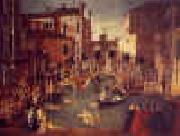 |
Gentile Bellini
|
|
Italian
c1429-1507
Gentile Bellini Gallery
(b Venice, ?1429; d Venice, 23 Feb 1507). Painter and draughtsman, son of (1) Jacopo Bellini. An official painter of the Venetian Republic, he was a dominant figure in Venetian art for several decades in the latter half of the 15th century, known particularly for portraits and large narrative paintings in which the city and its inhabitants are depicted in great detail. |
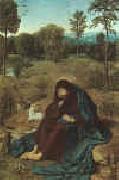 |
Geertgen Tot Sint Jans
|
|
Netherlandish Northern Renaissance Painter, ca.1460-1490
Geertgen tot Sint Jans is also known as Geertgen van Haarlem, Gerrit van Haarlem, or Gerrit Gerritsz.[citation needed] Alternative spellings of his first name are Gheertgen, Geerrit, and Gheerrit, where G(h)eertgen is the diminutive form of G(h)eerrit.
Presumably, he was born in Leiden, then in the Burgundian Netherlands in the Holy Roman Empire, around the year 1465. The assignment of Leiden as his birth place is traceable to a 17th century print by Jacob van Matham. There is no known archival evidence for this claim by Jacob van Matham. The modern acceptance of Leiden as Geertgen's birth place is roughly traceable to Johann Kessler's dissertation of 1930.
Probably, Geertgen was a pupil of Albert van Ouwater, who was one of the first oil painters in the northern Low Countries. Both painters lived in the city of Haarlem. Geertgen was attached to the monastery of the Knights of Saint John, for whom he painted an altarpiece. Although Geertgen was not a member of the Order of Saint John, his last name "tot Sint Jans" was derived from the order's name and means "unto Saint John".
Geertgen died in Haarlem, then the Habsburg Netherlands in the Holy Roman Empire, around the year 1495, when he was approximately 28 years old. He was buried in the monastery of the Knights of Saint John. Modern scholars have attempted to calculate the artist's death date with the information from The Painting-Book (Middle Dutch: Het Schilder-Boeck) by Karel van Mander, published in 1604. There are some archival traces that suggest he may in fact have lived into the 16th century. |
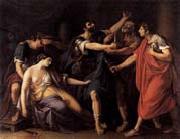 |
Gavin Hamilton
|
|
Scottish Neoclassical Painter, 1723-1798,Scottish painter, archaeologist and dealer, active in Italy. He was educated at Glasgow University and in 1748 arrived in Rome to study portrait painting under Agostino Masucci. He lodged with the architects James Stuart and Nicholas Revett; they probably encouraged him to visit Herculaneum and the recently discovered archaeological site of Pompeii, which had a profound effect on his subsequent career. Convinced that 'the ancients have surpassed the moderns, both in painting and sculpture', Hamilton undertook a systematic study of Classical antiquities during the 1750s and 1760s. In 1751 he was briefly in Scotland, where he painted a full-length portrait of Elizabeth Gunning, Duchess of Hamilton (Lennoxlove, Lothian), in a conventional style derived from van Dyck. He returned to Rome in 1752 and remained there, with the exception of short visits to England, for the rest of his life. In 1755 he was introduced by Anton Raphael Mengs to Johann Joachim Winckelmann, who was to become one of the leading theorists of Neo-classicism. In the same year Hamilton entertained Robert Adam, who studied in Rome from 1755 to 1757. He was to know and encourage almost all the British artists who worked in Rome during the second half of the 18th century. Henry Fuseli, who was not an uncritical admirer, wrote of Hamilton in 1805, |
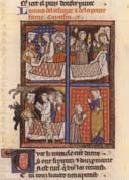 |
Gautier de Coinci
|
|
1177-1236 French,Born of noble stock, Gautier became a Benedictine novice at Saint-M??dard de Soissons in 1193 and prior at Vic-sur-Aisne in 1214, returning to Saint-M??dard to be grand prior (1233) until his death. His single work, preserved in nearly 80 manuscripts, is the massive Miracles de Nostre Dame, written at Vic (1214-27) and occupying some 30, 000 lines in two books. |
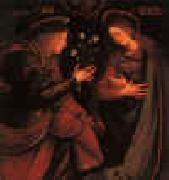 |
Gaudenzio Ferrari
|
|
1741-1546
Italian
Gaudenzio Ferrari Location
Italian painter and sculptor. He probably received his training at Varallo at the beginning of the 1490s, a lively period in the town artistic life, when extensive works were being carried out at the sacromonte. His master was Gian Stefano Scotto ( fl 1508), none of whose works has as yet been identified but who, judging from the early work of his pupil, may have been influenced by Lombard artists. Gaudenzio early works, such as a painting on panel of the Crucifixion (Varallo, Mus. Civ. Pietro Calderini), were influenced by the poetic art of Bramantino and by the northern Italian classicizing style of the Milanese painter Bernardo Zenale. His early, but self-assured, Angel of the Annunciation (c. 1500; Vercelli, Mus. Civ. Borgogna), painted for the Convento delle Grazie, Vercelli, suggests that these sources were soon enriched by his response to the tender Renaissance style of Pietro Perugino (active at the Certosa di Pavia, 1496-9). Gaudenzio is also recorded at Vercelli in the first known documentary reference to him, the contract for a polyptych commissioned by the Confraternit? di Sant Anna in 1508, with Eusebio Ferrari acting as guarantor. There remain four paintings of scenes from the Life of St Anne and God the Father (Turin, Gal. Sabauda) and two of the Annunciation (London, N.G.). In these works Gaudenzio style is more controlled, possibly as a result of a journey to central Italy in c. 1505. |
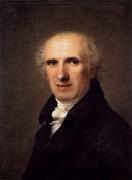 |
Gaspare Landi
|
|
Italian, 1756-1830,was an Italian painter of the Neoclassic period, active in Rome and his native city of Piacenza. He is said to have been a fun-loving younth, but in 1781 he procured a subsidy to study painting in Rome from patron and distant relative, Marquis Giambattista Landi. At age 25, he moved to Rome to work under Domenico Corvi and Pompeo Battoni. He is considered a rival of Vincenzo Camuccini. Two of his pictures were once in the Pinacoteca at Parma, Diomedes and Ulysses bearing off the Palladium (1783) and the Marriage of Abraham and Sarah. Above one of the altars in the church of the Santa Casa at Loreto there is a later work by this Landi showing the Madonna addolorata. A major work is his large canvas representing the fainting of Christ as he struggles along over the road to Calvary weighted down by the burden of the Cross, Lo Spasimo for San Giovanni at Piacenza. It hung opposite Vincenzo Camuccini's Presentation. Landi became a member of the Accademia di San Luca of Rome in 1805, professor of the theory of painting in 1812, and president of the Academy in 1817. He was also made a Chevalier of the Order of the Iron Crown, of the Order of San Giuseppe, and of a Neapolitan order. About 1820 he returned to Piacenza, intending to remain there, but soon tired of the monotonous existence of a provincial town, and in 1824 reestablished himself at Rome. His last work was an Assumption and was placed in the church of San Francesco di Paola, at Naples. He returned to Piacenza in 1829, where he died. |
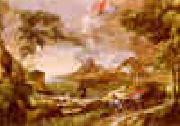 |
Gaspard Dughet
|
|
1615-1675
French Gaspard Dughet Location
Italian painter. He was one of the most distinguished landscape painters working in Rome in the 17th century, painting decorative frescoes and many easel paintings for such major Roman patrons as Pope Innocent X and the Colonna family. He is associated with a new genre of landscape, the storm scene, although of some 400 catalogued works little more than 30 treat this theme. His most characteristic works depict the beauty of the scenery around Rome, particularly near Tivoli, and suggest the shifting patterns of light and shade across a rugged terrain. Dughet drew from nature, yet his landscapes are carefully structured, and figures in antique dress suggest the ancient beauty of a landscape celebrated by Virgil. Very few can be securely dated; his development may be inferred from his few dated fresco paintings and from the wider context in which he was working. Most writers, following Pascoli, have divided Dughet career into three periods. His first landscapes were a little dry (Pascoli); in his second period he developed a more learned style, closer to that of his teacher, Nicolas Poussin; his late works were more intimate and more original.
|
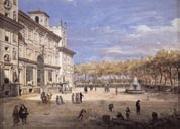 |
Gaspar Van Wittel
|
|
Dutch Baroque Era Painter, ca.1653-1736
was a Dutch landscape painter. Van Wittel learned painting in his hometown of Amersfoort. His first extant works were made in Hoorn in 1672, but he relocated to Rome with his family ca. 1675 and made his career there. In Amersfoort, he likely was exposed to Dutch landscape artists such as Jan van der Heyden and Gerrit Berckheyde. He married in Rome in 1697, and stayed most of his life in that city, though, between 1694 and 1710, he toured Italy and painted in places like Florence, Bologna, Ferrara, Venice, Milan, Piacenza and Naples. He is one of the principal painters of topographical views known as vedute. His son Luigi would become a famous architect and also carries the italianized family name of Vanvitelli. In Luigi's biography is written that his father was born in July 1656, |
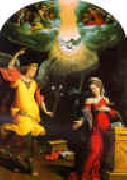 |
Garofalo
|
|
1481-1559
Italian
Garofalo Gallery
Italian painter. Active mainly in Ferrara and the district around the Po delta, he was one of the most outstanding figures in Emilian classicism during the first half of the 16th century. In 1497 Garofalo father paid Boccaccio Boccaccino to teach his son the rudiments of painting. Garofalo first works were directly influenced by the Cremonese painter, to whom they were formerly even attributed. They consist of a series of small paintings depicting the Virgin and Child. The example in the Ca d Oro in Venice must have been Garofalo first painting and reveals not only the lessons learned from Boccaccino, but also signs of the influence of Domenico Panetti (c. 1460-before 1513), traditionally recorded as his first master. Another Virgin and Child (Assisi, Perkins priv. col.) shows signs of the early influence of Lorenzo Costa the elder, while the example in the Nationalmuseum, Copenhagen, shows a similarity with the early works of his contemporary, Lodovico Mazzolino. A particularly important project in Ferrara during the earliest years of the 16th century, involving numerous highly skilled artists, was the fresco decoration of the oratory of the Concezione. The frescoes (Ferrara, Pin. N.) represent a significant development in the city art. Garofalo hand has been identified in the Presentation in the Temple, in which he reveals a familiarity not only with local art, but also with the high points of Bolognese classicism, whose greatest exponents were Francesco Francia and Lorenzo Costa the elder. Around 1505, Garofalo works show a close familiarity with artistic developments in Bologna, in particular the mature style of Costa and the decoration in 1505-6, by Francesco Francia, Costa, Aspertini and others, of the oratory of S Cecilia in S Giacomo Maggiore. Garofalo Virgin Enthroned between SS Martin and Rosalia (Florence, Uffizi), created for Codigoro Cathedral, should be seen within this context, whereas the small altarpiece for the Arcivescovado, Ferrara, although executed at the same time, shows early, if faint, signs of the influence of Venetian painting of the period. |
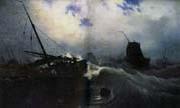 |
Garneray Ambroise
|
|
French Artist ,
Paris 1783-1857
French corsair, painter and writer. He served under Robert Surcouf and Jean-Marie Dutertre, and was held prisoner by the British for eight years. Garneray was born in Paris (on Rue Saint-Andre-des-arts, in the Latin Quarter) on February 9, 1783. He was the elder son of Jean-Francois Garneray (1755 - 1837), painter of the king, who was pupil of Jacques-Louis David. At thirteen, he joined the Navy as a seaman, encouraged by his cousin, Beaulieu-Leloup, commander of the frigate Forte ("the Stout one"). Garneray sailed from Rochefort to the Indian Ocean with the frigate division under Sercey, to which the Forte belonged. Garneray took part in the various campaigns of Sercey division and witnessed the hardship it met in the battle against Arrogant and Victorious. He then served in 1798 on the corvette Brule Gueule ("Mouth burner"), which patrolled with the frigate Preneuse ("the Taker"). Returning from this campaign, the Brule Gueule and Preneuse were chased by a British squadron comprising two ships of the line, one frigate and one corvette; the French flew into a creek near Black River whose shallow waters prevented the British from pursuing. The next day, the British squadron attacked; the French had established strong defensive positions by installing the unusable batteries of their ships ashore, and repelled the British squadron. In 1799, |
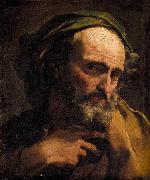 |
Gandolfi,Gaetano
|
|
Gaetano Gandolfi (31 August 1734 - 20 June 1802) was an Italian painter of the late Baroque and early Neoclassic period, active in Bologna.
Gaetano was born in San Matteo della Decima, near Bologna, to a family of artists. Ubaldo Gandolfi was his brother, Mauro Gandolfi was his son, and Democrito Gandolfi was his grandson. Gaetano became a "student" at the Accademia Clementina in Bologna, where he was taught by Felice Torelli and Ercole Lelli. In the academy, he was the recipient of several prizes for both figure drawing and sculpture. Later, in an autobiography, Gaetano claimed Felice Torelli (1667-1748) as his master. Other sources mention Ercole Graziani the Younger (1688-1765) and Ercole Lelli. He traveled to England, and became strongly influenced by Tiepolo. Gaetano died in Bologna, Italy.
|
 |
Gallego,Fernando
|
|
Fernando Gallego (c. 1440 - 1507) was a Spanish painter, brought up in an age of gothic style, his art is generally regarded as Hispano-Flemish style. It's thought that he was born in Salamanca, Spain, and his first known works were in the cathedrals of Plasencia and Coria, in Ceeres (Spain). His most famous known works are:
The Retablo of San Ildefonso, in the Cathedral of Zamora, Spain
The Sky of Salamanca, in the University of Salamanca, Spain
The Retablo of Ciudad Rodrigo, now at the University of Arizona, Arizona, USA
The Arcenillas' panels, placed in Zamora, Spain
San Acacio and the 10,000 Martyrs, at the Meadows Museum, Dallas, Texas, USA
The last time that he was named in a document is in 1507, but the date of his death is unknown.
|
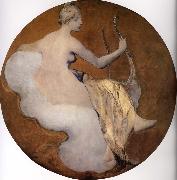 |
Galland Pierre Victor
|
|
Geneve 1822-Paris 1892
He studied metalwork with his father Jacques Galland, an accomplished goldsmith, until age 16. He then entered the studio of Henri Labrouste to study architecture. After two years of training, Labrouste encouraged him to pursue his interest in decorative painting under the direction of Michel-Martin Drolling. In 1843 the decorative painter Pierre-Luc-Charles Ciceri (1782-1868) hired Galland to assist with the painting of figures, flowers, garlands and fruit. He worked again with Labrouste, in 1848, on the decoration of the national festival, the F?te de la Concorde. |
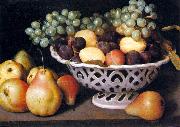 |
Galizia,Fede
|
|
Fede Galizia (1578 - 1630) was an Italian Renaissance painter, a pioneer of the still life genre.
|
 |
Galeazzo Campi
|
|
(1475/1477 - 1536) was an Italian painter of the Renaissance from Cremona. He was a pupil of Boccaccio Boccaccinis . His representation was rather rigid, but careful. His landscapes show influences of Perugino and Giovanni Bellini.
Campi was the head of an artist family, existing in the middle and end of 16th Century who lived in Cremona and left numerous works of art. His three sons, Giulio Campi, Antonio Campi and Vincenzo Campi are historically noteworthy.
|
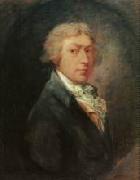 |
GAINSBOROUGH, Thomas
|
|
English Rococo Era/Romantic Painter, 1727-1788
English painter, draughtsman and printmaker. He was the contemporary and rival of Joshua Reynolds, who honoured him on 10 December 1788 with a valedictory Discourse (pubd London, 1789), in which he stated: 'If ever this nation should produce genius sufficient to acquire to us the honourable distinction of an English School, the name of Gainsborough will be transmitted to posterity, in the history of Art, among the very first of that rising name.' He went on to consider Gainsborough's portraits, landscapes and fancy pictures within the Old Master tradition, against which, in his view, modern painting had always to match itself. Reynolds was acknowledging a general opinion that Gainsborough was one of the most significant painters of their generation. Less ambitious than Reynolds in his portraits, he nevertheless painted with elegance and virtuosity. He founded his landscape manner largely on the study of northern European artists and developed a very beautiful and often poignant imagery of the British countryside. By the mid-1760s he was making formal allusions to a wide range of previous art, from Rubens and Watteau to, eventually, Claude and Titian. He was as various in his drawings and was among the first to take up the new printmaking techniques of aquatint and soft-ground etching. Because his friend, the musician and painter William Jackson (1730-1803), claimed that Gainsborough detested reading, there has been a tendency to deny him any literacy. He was, nevertheless, as his surviving letters show, verbally adept, extremely witty and highly cultured. He loved music and performed well. He was a person of rapidly changing moods, humorous, brilliant and witty. At the time of his death he was expanding the range of his art, having lived through one of the more complex and creative phases in the history of British painting. He painted with unmatched skill and bravura; while giving the impression of a kind of holy innocence, he was among the most artistically learned and sophisticated painters of his generation. It has been usual to consider his career in terms of the rivalry with Reynolds that was acknowledged by their contemporaries; while Reynolds maintained an intellectual and academic ideal of art, Gainsborough grounded his imagery on contemporary life, maintaining an aesthetic outlook previously given its most powerful expression by William Hogarth. |
 |
Gaetano previati
|
|
Italian Painter, 1852-1920
Italian painter and writer. He was one of the leading exponents of Divisionism, particularly skilled at large-scale decorative schemes, and especially important for his writings on technique and theory. |
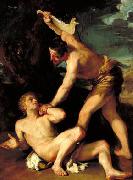 |
Gaetano Gandolfi
|
|
(August 31, 1734 - June 20, 1802) was an Italian painter of the late Baroque and early Neoclassic period, active in Bologna.
Gaetano was born in San Matteo della Decima, near Bologna, to a family of artists. Ubaldo Gandolfi was his brother, Mauro Gandolfi was his son, and Democrito Gandolfi was his grandson. Gaetano became a "student" at the Accademia Clementina in Bologna, where he was taught by Felice Torelli and Ercole Lelli. In the academy, he was the recipient of several prizes for both figure drawing and sculpture. Later, in an autobiography, Gaetano claimed Felice Torelli (1667 - 1748) as his master. Other sources mention Ercole Graziani the Younger (1688 - 1765) and Ercole Lelli. He traveled to England, and became strongly influenced by Tiepolo. Gaetano died in Bologna, Italy.
|
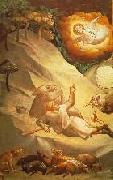 |
GADDI, Taddeo
|
|
Italian Early Renaissance Painter, ca.1300-1366
Italian painter active in Florence. He was the son of a painter and mosaicist and a student of Giotto. His best-known works are frescoes in the church of Santa Croce in Florence. He directed a flourishing workshop for three decades, producing pictures in the style of Giotto but featuring more vivid picturesque effects with narrative detail. His son and pupil Agnolo (c. 1350 C 96) was an influential and prolific artist who likewise produced a notable series of frescoes for Santa Croce, The Legend of the True Cross |
 |
Gabriele Capellini
|
|
Gabriele Capellini was an Italian painter of the Renaissance.He was also called il Caligarino or il Calzolaretto (the little shoemaker), from his having first pursued that trade. He born in Ferrara, and there trained under Dosso Dossi, he was active c. 1520. For the church of San Francesco at Ferrara St. Peter and St. James and for San Giovannino the principal altar-piece, representing The Virgin and Infant with several Saints.
|
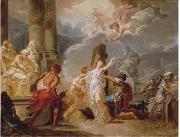 |
Gabriel-Francois Doyen
|
|
(1726 - 5 June 1806) was a French painter, who was born at Paris.
His passion for art prevailed over his father's wish, and he became in his twelfth year a pupil of Charles-Andra van Loo. Making rapid progress, he obtained at twenty the Grand Prix, and in 1748 set out for Rome. He studied the works of Annibale Carracci, Pietro Berrettini da Cortona, Giulio Romano and Michelangelo, then visited Naples, Venice, Bologna and other Italian cities, and in 1755 returned to Paris. At first unappreciated and disparaged, he resolved by one grand effort to achieve a reputation, and in 1758 he exhibited his Death of Virginia. It was completely successful, and procured him admission to the Acad??mie Royale de Peinture et de Sculpture. Among his greatest works are reckoned the Miracle des Ardents, painted for the church of St Genevieve at St Roch (1767)this painting was exhibited in the salon of 1767 which was recorded by Saint-Aubin in "View of the salon of 1767"; the Triumph of Thetis, for the chapel of the Invalides; and the Death of St Louis, for the chapel of the Military School. In 1776 he was appointed professor at the Academy. Soon after the beginning of the French Revolution he accepted the invitation of Catherine II of Russia. and settled at St Petersburg, where he was loaded with honors and rewards. He died there on 5 June 1806.
|
 |
Gabriel von Max
|
|
(August 23, 1840 - November 24, 1915) was a Prague-born Austrian painter.
He was born Gabriel Cornelius Max, the son of Czech sculptor Joseph Max and Anna Schumann. He studied between 1855 and 1858 at the Prague Academy of Arts with Eduard von Engerth. His studies included parapsychology (somnambulism, hypnotism, spiritism), Darwinism, Asiatic philosophy, the ideas of Schopenhauer, and various mystical traditions. The spiritual-mystical movement was emphasized by the writings of Carl du Prel, and the Munich painter Albert Keller was also an influence.
His first large canvas was painted in 1858 while he was a student at the Prague Academy. He continued his studies at the Viennese Academy of Art with Karl von Blaas, Karl Mayer, Christian Ruben and Carl Wurzinger. From 1863 to 1867 he studied at the Munich Academy with Karl Theodor von Piloty, and also Hans Makart and Franz Defregger. His first critical success was in 1867 with the painting "Martyr at the Cross": that painting transformed the "Ungl?-ksmalerei" (dark palette) of Piloty into a religious-mystical symbolism using a psychological rendering of its subject.
He continued to use the dark palette of the Piloty school well into the 1870s, later moving toward a more muted palette, using fewer,clearer colors. From 1869, Gabriel von Max had his studio in Munich; in the summer, he was in the Ammerland at Starnberger Lake. From 1879-1883, Gabriel Max was a professor of Historical Painting at the Munich Academy; he also became a Fellow of The Theosophical Society. In 1900 he was ennobled and became a Ritter. He died in Munich in 1915.
His interest in anthropological studies also showed in his work. He owned a large scientific collection of prehistoric ethnological and anthropological finds: the collection now resides in the Stadtischen Reiss Museum in Mannheim. At his residence in Starnberger Lake, Gabriel Max surrounded himself with a family of monkeys, which he painted often, sometimes portraying them as human. Max, along with his colleagues, often used photographs to guide painting. The great number of monkey photographs in his archive testify to their use as direct translation into his paintings. In 1908, his painting "The Lion's Bride" became celebrated, and was depicted in motion pictures as an hommage in the Gloria Swanson film, Male and Female, (1919), directed by Cecil B. de Mille.
Gabriel von Max was a significant artist to emerge from the Piloty School, because he abandoned the themes of the Grunderzeitliche (genre and history), in order to develop an allegorical-mystical pictorial language, which became typical of Secessionist Art. Characteristic of the ethereal style of Gabriel Max is "The Last Token" (in the Metropolitan Museum), and "Light" (in the Odessa Museum of Western and Eastern Art, Ukraine).
|
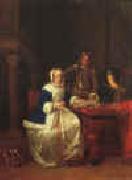 |
Gabriel Metsu
|
|
1629-1667
Dutch
Gabriel Metsu Galleries
One of his earliest pictures is the "Lazarus" at the Strassburg Museum, painted under the influence of Jan Steen. In 1653 under the influence of Rembrandt he painted "Woman taken in Adultery," a large picture which is now in the Louvre. To the same period belong the "Departure of Hagar," formerly in the Thore collection, and the "Widow's Mite" at the Schwerin Gallery. But he probably observed that sacred art was ill suited to his temper, or he found the field too strongly occupied, and turned to other subjects for which he was better fitted. That at one time he was deeply impressed by the vivacity and bold technique of Frans Hals can be gathered from Lord Lonsdale's picture of "Women at a Fishmonger's Shop."
What Metsu undertook and carried out from the first with surprising success was the low life of the market and tavern, contrasted, with wonderful versatility, by incidents of high life and the drawing-room. In no single instance do the artistic lessons of Rembrandt appear to have been lost upon him. The same principles of light and shade which had marked his schoolwork in the "Woman taken in Adultery" were applied to subjects of quite a different kind. A group in a drawing-room, a series of groups in the market-place, or a single figure in the gloom of a tavern or parlour, was treated with the utmost felicity by fit concentration and gradation of light, a warm flush of tone pervading every part, and, with that, the study of texture in stuffs was carried as far as it had been by Ter Borch or Gerard Dou, if not with the finish or the brio of De Hooch.
One of the best pictures of Metsu's manhood is the "Market-place of Amsterdam," at the Louvre, respecting which it is difficult to distribute praise in fair proportions, so excellent are the various parts, the characteristic movement and action of the dramatis personae, the selection of faces, the expression and the gesture, and the texture of the things depicted. Equally fine, though earlier, are the "Sportsman" (dated 1661) and the "Tavern" (also 1661) at the Hague and Dresden Museums, and the "Game-Dealer's Shop," also at Dresden, with the painter's signature and 1662.
Gabriel Metsu, Man Writing a Letter (1662-1665), Oil on canvas, National Gallery of Ireland, DublinAmong the five examples of the painter in the Wallace Collection, are "The Tabby Cat," and "The Sleeping Sportsman," which cost Lord Hertford £ 3000, is an admirable example technically considered. Among his finest representations of home life are the "Repast" at the Hermitage in St Petersburg; the "Mother nursing her Sick Child" in the Rijksmuseum in Amsterdam; the "Amateur Musicians" at the Hague Gallery; the "Duet" and the "Music Lesson" at the National Gallery, London, and many more examples at nearly all the leading European galleries. Five of his painting are in Dresden, collected by August the Strong. |
 |
Gabriel Metsu
|
|
Gabriël Metsu
Gabriël Metsu (January 1629 - buried 24 October 1667) was a Dutch painter of history paintings, genre works and portraits.
Metsu was the son of the Flemish painter Jacques Metsu (c.1588-1629), who lived most of his days at Leiden, and Jacomijntje Garniers, his third wife, whom he married in 1625. Jacomijntje was the widow of a painter with three children of her own. Two months after Gabriël's birth, his father died.
According to Jacobus Houbraken, Metsu was taught by Gerard Dou, though his early works do not lend colour to this assertion. He was influenced by painters of Leiden such as Jan Steen, and later by Frans van Mieris the Elder.
Metsu was registered among the first members of the painters' corporation at Leiden; and the books of the guild also tell us that he remained a member in 1649. In Leiden, it was alleged that Metsu left a brothel at six in the morning and took a prostitute to the Academy. In 1650 he ceased to subscribe, and works bearing his name and the date of 1653 support the belief that he had moved. Metsu was trained in Utrecht by Jan Baptist Weenix and Nicolaus Knepfer.
In Amsterdam Metsu lived in an alley on Prinsengracht, where he kept chickens. He got into an argument with a neighbor and moved to a house on the canal side, where a daily vegetable market was held. In 1658 he married Isabella de Wolff, whose father was a potter and mother a painter. The Speed Art Museum has a portrait of the couple. Pieter de Grebber, a religious painter from Haarlem, was her uncle.
At the onset of the 1660s Metsu turned for inspiration to the art of the "fijnschilders" from his native Leiden. Metsu was responding to the market of Dou's paintings, who sold his paintings all over for exorbitant prices. Metsu may have also influenced Pieter de Hoogh. Around the year 1661, Metsu won the patronage of the Amsterdam cloth merchant Jan J. Hinlopen and painted his family more than once in a fashionable surrounding.
The Poultry-Seller, 1662
At least thirteen of paintings show carpets and he probably used the same model. He included several fine examples of minutely depicted floral and cloudband carpets in his works and even a silk Oriental rug, as well as so-called "Lotto" rugs which he for some reason, in contrast to his meticulous rendering of the floral carpets, depicted only in a very sketchy fashion. After Metsu died, his widow left for Enkhuizen, to live with her mother. |
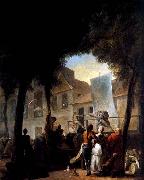 |
Gabriel Jacques de Saint-Aubin
|
|
French Painter, 1724-1780,Draughtsman, etcher and painter, brother of (1) Charles-Germain de Saint-Aubin. He studied with the painters Etienne Jeaurat and Hyacinthe Colin de Vermont, but failed three times to win the Prix de Rome (competition paintings, 1752-4; Paris, Louvre). He broke with the Academie Royale, preferring to support and exhibit at the Academie de St Luc. Although he continued to paint such pictures as a Street Show in Paris (c. 1760; London, N.G.; other examples in Rouen, Mus. B.-A.), he is best known as a draughtsman and etcher. He was a passionate and unconventional observer of the sights of the Paris streets and of the social scene. Dacier saw him as the 'man who drew at all times and in all places', and his contemporary Jean-Baptiste Greuze spoke of his 'priapism of draughtsmanship'. In his many drawings he combined pencil, black and red chalk, bistre, ink and watercolour to create dazzling spontaneous effects. He drew incidents that struck him as he wandered the streets, or entertainments that he attended. He recorded them, noting dates and times, in sketchbooks (e.g. Paris, Louvre and Stockholm, Nmus.) or sometimes in the margins and blank pages of printed books that he was carrying (such as a volume of the poems of Jean-Michel Sedaine, in the Mus. Cond?, Chantilly). These drawings of contemporary incidents include the Fire at the Foire Saint-Germain on the Night of 16-17 May 1762 (ex-David Weill priv. col.) and the Crowning of Voltaire at the Theetre-Franeais in 1778 (Paris, Louvre; see fig.). He went regularly to the Salon of the Academie Royale and to art sales, covering the margins and flyleaves of his sale catalogues and Salon livrets with tiny sketches of works of art and the passing scene. One hundred of these illustrated catalogues were among his effects when he died, and of these about a third survive. These include the livrets for the Salons of 1761, 1769 and 1777 (all Paris, Bib. N.), as well as the catalogues of the sales of Louis-Michel van Loo in 1772 and Charles Natoire in 1778 (both Paris, Bib. N.), and that of Pierre-Jean Mariette in 1775 (Boston, MA, Mus. F.A.). Together with his etchings and large watercolours (e.g. Paris, Louvre) of the Louvre's Salon Carre at the time of the exhibitions of 1753, 1767 and 1769, |
 |
Gabrie Metsu
|
|
Gabriël Metsu (January 1629 - buried 24 October 1667) was a Dutch painter of history paintings, genre works and portraits.
Metsu was the son of the Flemish painter Jacques Metsu (c.1588-1629), who lived most of his days at Leiden, and Jacomijntje Garniers, his third wife, whom he married in 1625. Jacomijntje was the widow of a painter with three children of her own. Two months after Gabriël's birth, his father died.
According to Jacobus Houbraken, Metsu was taught by Gerard Dou, though his early works do not lend colour to this assertion. He was influenced by painters of Leiden such as Jan Steen, and later by Frans van Mieris the Elder.
Metsu was registered among the first members of the painters' corporation at Leiden; and the books of the guild also tell us that he remained a member in 1649. In Leiden, it was alleged that Metsu left a brothel at six in the morning and took a prostitute to the Academy. In 1650 he ceased to subscribe, and works bearing his name and the date of 1653 support the belief that he had moved. Metsu was trained in Utrecht by Jan Baptist Weenix and Nicolaus Knepfer.
The alley on Prinsengracht
In Amsterdam Metsu lived in an alley on Prinsengracht, where he kept chickens. He got into an argument with a neighbor and moved to a house on the canal side, where a daily vegetable market was held. In 1658 he married Isabella de Wolff, whose father was a potter and mother a painter. The Speed Art Museum has a portrait of the couple. Pieter de Grebber, a religious painter from Haarlem, was her uncle.
|
 |
G. Fuchs
|
|
painted Bolle Willum Luxdorph in 1782(1782)
|
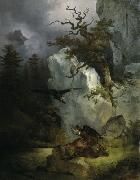 |
Friedrich Gauermann
|
|
(September 10, 1807 - July 7, 1862), Austrian painter, son of the landscape painter Jacob Gauermann (1773 - 1843), was born at Miesenbach near Gutenstein in Lower Austria.
It was the intention of his father that he should devote himself to agriculture, but the example of an elder brother, who, however, died early, fostered his inclination towards art. Under his father's direction he began studies in landscape, and he also diligently copied the works of the chief masters in animal painting which were contained in the academy and court library of Vienna. In the summer he made art tours in the districts of Styria, Tirol, and Salzburg.
Two animal pieces which he exhibited at the Vienna Exhibition of 1824 were regarded as remarkable productions for his years, and led to his receiving commissions in 1825 and 1826 from Prince Metternich and Caraman, the French ambassador. His reputation was greatly increased by his picture "The Storm," exhibited in 1829, and from that time his works were much sought after and obtained correspondingly high prices. His "Field Labourer" was regarded by many as the most noteworthy picture in the Vienna exhibition of 1834, and his numerous animal pieces have entitled him to a place in the first rank of painters of that class of subjects.
The peculiarity of his pictures is the representation of human and animal figures in connexion with appropriate landscapes and in characteristic situations so as to manifest nature as a living whole, and he particularly excels in depicting the free life of animals in wild mountain scenery. Along with great mastery of the technicalities of his art, his works exhibit patient and keen observation, free and correct handling of details, and bold and clear colouring. He died at Vienna on the 7th of July 1862.
Many of his pictures have been engraved, and after his death a selection of fifty-three of his works was prepared for this purpose by the Austrian Kunstverein (Art Union).
|
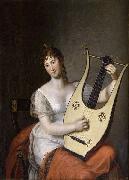 |
Friedrich Carl Groger
|
|
(14 October 1766, Plön - 9 November 1838, Hamburg) was a north-German portrait painter and lithographer. One of the most respected portraitists of his time in northern Germany, his works are to be found in several museums, including the Hamburger Kunsthalle, as well as in north German, Holstein and Danish private collections.
Gröger was the son of a tailor in Plön, where he grew up in modest circumstances. His parents wanted him to become a tailor or wood turner and opposed his early artistic activities. He was largely self taught in painting, though he had some contact in Lebeck with Tischbein and in 1785 was in the city of Lebeck, where he met Heinrich Jacob Aldenrath, his first, loyalest and lifelong friend - the Grögersweg in Hamburg-Barmbek named after him links the Tischbeinstraße with the Aldenrathsweg.
From 1789 he studied at Berlin's Akademie der Kenste. He and Aldenrath then went together to Hamburg, then on a joint study trip to Dresden and Paris, then back to Lebeck, where he worked until 1807. They then alternated between Hamburg, Copenhagen, Kiel and Lebeck, before finally settling in Hamburg in 1814. In 1792 Gröger was made an honorary member of the Gesellschaft zur Beförderung gemeinnetziger Tätigkeit in Lebeck.
Gröger developed from a miniature painter into a portrait painter, who towards the end of his life preferred three quarter bust portraits. Aldenrath took over the miniature painting side of their joint business. After lithography developed in northern Germany, they both worked in this medium individually as well as jointly under the business name Firma Gröger & Aldenrath.
|
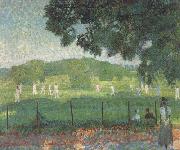 |
Frederick spencer gore
|
|
British. 1878 - 1914.
English painter. He studied at the Slade School of Fine Art, London (1896-9), where he met Harold Gilman, who became a close friend. In 1902 he visited Spain with another Slade contemporary, Wyndham Lewis, and two years later he visited Sickert in Dieppe. From that time on his work was influenced by French art, and Gore learnt much about Degas's paintings through Sickert's teaching. After Sickert's return to London in 1905 Gore frequently accompanied him to music halls and made them the subject of several paintings, for example The Mad Pierrot Ballet, the Alhambra |
 |
Frederick goodall,R.A.
|
|
1822-1904
son of Edward Goodall. He was taught by his father and first exhibited at the Royal Academy in 1838. His earliest subjects were rural genre scenes and landscapes, many derived from sketching trips made between 1838 and 1857 in Normandy, Brittany, Wales, Ireland, Scotland and Venice. In the 1850s he also painted subjects from British history. More significant for his subsequent career was his visit to Egypt from September 1858 to April 1859. In Cairo he lived in a house in the Coptic quarter with Carl Haag. Together the two artists went on expeditions to Giza to draw the Nile, the Sphinx and Pyramids, and to Suez and across the Red Sea to the Wells of Moses at 'Uyen Mesa. Goodall also made rapid sketches in the crowded streets of Cairo. 'My sole object in paying my first visit to Egypt', he wrote, 'was to paint Scriptural subjects'. The first of these, Early Morning in the Wilderness of Shur (London, Guildhall A.G.), was exhibited at the Royal Academy in 1860 and won him critical and popular acclaim. In 1864 he was elected RA. Much of the rest of Goodall's long career was devoted to painting similar scenes of Egyptian life with biblical associations, for which he made reference to his sketches and to Egyptian artefacts and clothing. Their success prompted a second visit to Egypt in 1870-71. |
|
|
Frederick Goodall,R.A
|
|
1822-1904
Painter, son of (1) Edward Goodall. He was taught by his father and first exhibited at the Royal Academy in 1838. His earliest subjects were rural genre scenes and landscapes, many derived from sketching trips made between 1838 and 1857 in Normandy, Brittany, Wales, Ireland, Scotland and Venice. In the 1850s he also painted subjects from British history. More significant for his subsequent career was his visit to Egypt from September 1858 to April 1859. In Cairo he lived in a house in the Coptic quarter with Carl Haag. Together the two artists went on expeditions to Giza to draw the Nile, the Sphinx and Pyramids, and to Suez and across the Red Sea to the Wells of Moses at 'Uy?n M?sa. Goodall also made rapid sketches in the crowded streets of Cairo. 'My sole object in paying my first visit to Egypt', he wrote, 'was to paint Scriptural subjects' (Reminiscences, p. 97). The first of these, Early Morning in the Wilderness of Shur (London, Guildhall A.G.), was exhibited at the Royal Academy in 1860 and won him critical and popular acclaim. In 1864 he was elected RA. Much of the rest of Goodall's long career was devoted to painting similar scenes of Egyptian life with biblical associations, for which he made reference to his sketches and to Egyptian artefacts and clothing. |
 |
Frederick Goodall
|
|
British Painter, 1822-1904
Painter, son of Edward Goodall. He was taught by his father and first exhibited at the Royal Academy in 1838. His earliest subjects were rural genre scenes and landscapes, many derived from sketching trips made between 1838 and 1857 in Normandy, Brittany, Wales, Ireland, Scotland and Venice. In the 1850s he also painted subjects from British history. More significant for his subsequent career was his visit to Egypt from September 1858 to April 1859. In Cairo he lived in a house in the Coptic quarter with Carl Haag. Together the two artists went on expeditions to Giza to draw the Nile, the Sphinx and Pyramids, and to Suez and across the Red Sea to the Wells of Moses at 'Uyen Mesa. Goodall also made rapid sketches in the crowded streets of Cairo. 'My sole object in paying my first visit to Egypt', he wrote, 'was to paint Scriptural subjects'. The first of these, Early Morning in the Wilderness of Shur (London, Guildhall A.G.), was exhibited at the Royal Academy in 1860 and won him critical and popular acclaim. In 1864 he was elected RA. Much of the rest of Goodall's long career was devoted to painting similar scenes of Egyptian life with biblical associations, for which he made reference to his sketches and to Egyptian artefacts and clothing. Their success prompted a second visit to Egypt in 1870-71. |
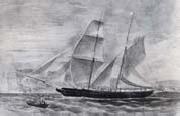 |
Frederick Garling
|
|
1775 - 1848,was an English attorney and solicitor, and was one of the first solicitors admitted in Australia and was regarded as the first senior solicitor of the second Supreme Court established in the colony of New South Wales, which is now a State of Australia. Garling is recognised as being one of the first crown solicitors in Australia. |
|

